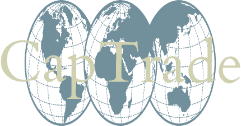Origins: How we Became CapTrade — Chapter 1: We Fly the Coop
February 2022 marks the 30th anniversary of Capital Trade, or CapTrade. To mark this event, we are changing our logo for a year, and also offering memories of our years together in the form of a serialized blog. The plan for the series is to be a (loosely chronological) history, with some diversions along the way for specific subjects. The focus is on our notable firsts and the humorous experiences from the first three decades. Enjoy and feel free to share.
Our origin story begins at the accounting firm of Coopers & Lybrand (now a part of PWC – PriceWaterhouseCoopers). The four principals who started CapTrade first worked together at C&L in the early 1980s. The creator of the first AD/CVD trade practice, Shannon Herzfeld, originally focused on countervailing duties, where new cases were being filed every month, and new methodologies derived from the world of finance were being used to measure subsidies. But new CVD cases declined over the decade. The action began to shift to dumping.
The C&L trade regulations group’s first big client was Akin Gump Strauss Hauer & Feld. Two of the four original principals, Chuck Anderson and Tom Rogers, met there. Both were in their early twenties, recently degreed worker bees in much larger organizations. On Memorial Day weekend 1984, Chuck and Tom slave around the clock to finalize approximately 20 antidumping/countervailing duty petitions. The photocopying task alone was enormous, so it had to be farmed out to an outside company. But because of the holiday, none of the big established copying centers in DC were open. Tom finally located a brand-new copy center in Maryland that literally was just setting up. When they arrived at the shop with the only copy of the precious original petitions, the copy machines were still being unpacked and set up. But the shop accepted the job, and somehow those 20 massive petitions were ready the next Tuesday morning.
Our first major respondent antidumping client was a Korean television manufacturer. The attorney representing the company came to us with a very specific problem: the U.S. Commerce Department’s Import Administration was calculating dumping margins using a computer program that they refused to release, even under administrative protective order (The DOC claimed that release of the program would allow companies to figure out a way to avoid dumping!). The lawyer, who was somewhat of a geek, had tried to construct a dumping calculation on his own using a primitive spreadsheet pre-cursor to Lotus and Excel known as “Viscalc.” Recognizing its inherent limitations, the lawyer asked us: could we “reverse engineer” the Commerce antidumping program, so that his client would have a way of estimating the potential duties, and playing “what if” games, before submitting its responses?
Not really knowing what we were getting into, we accepted the challenge. With no access to the actual antidumping program, we had no idea how the Commerce calculations worked. How and when were exchange rates applied? Were the calculations done in the foreign currency or the U.S. currency? How were sales below cost treated?
C&L’s substantial IT consulting practice was geared to large government contracts. Our need was tiny by its standards, so the C&L department heads suggested we use one of its regular subcontractors, Sakura Systems, led by Mary Ann McCleary, to write the dumping calculation code. Mary Ann wrote the original dumping margin estimates in COBOL, because SAS (the program used by Commerce) was available only for mainframe computers at the time. Essentially, we experimented and ran margins until we felt we were reasonably close to the Department’s final results. Now, we had something that none of our competitors had – a program to estimate dumping margins.
About the same time, we decided that we should be a full-service trade regulations consulting firm, offering both Commerce Department antidumping and CVD consulting, as well as U.S. International Trade Commission economic support for the injury side of these investigations. Somehow, we found Dan Klett (or Dan found us), an ITC economist. Dan was busy from day one, building a widely respected ITC practice.
So here we were, the original four, growing a consulting business from scratch, under the wing of one of the world’s largest accounting and consulting firms. We were serving important firm clients, getting new clients on our own, and making a name for ourselves, appearing in bigger and bigger cases. The market was growing, and law firms were beginning to believe that a consulting partner in AD/CVD/Injury proceedings was essential.
And then we were fired . . . . . .
Next up: Chapter 2: Getting Axed and Landing in a Halfway House




